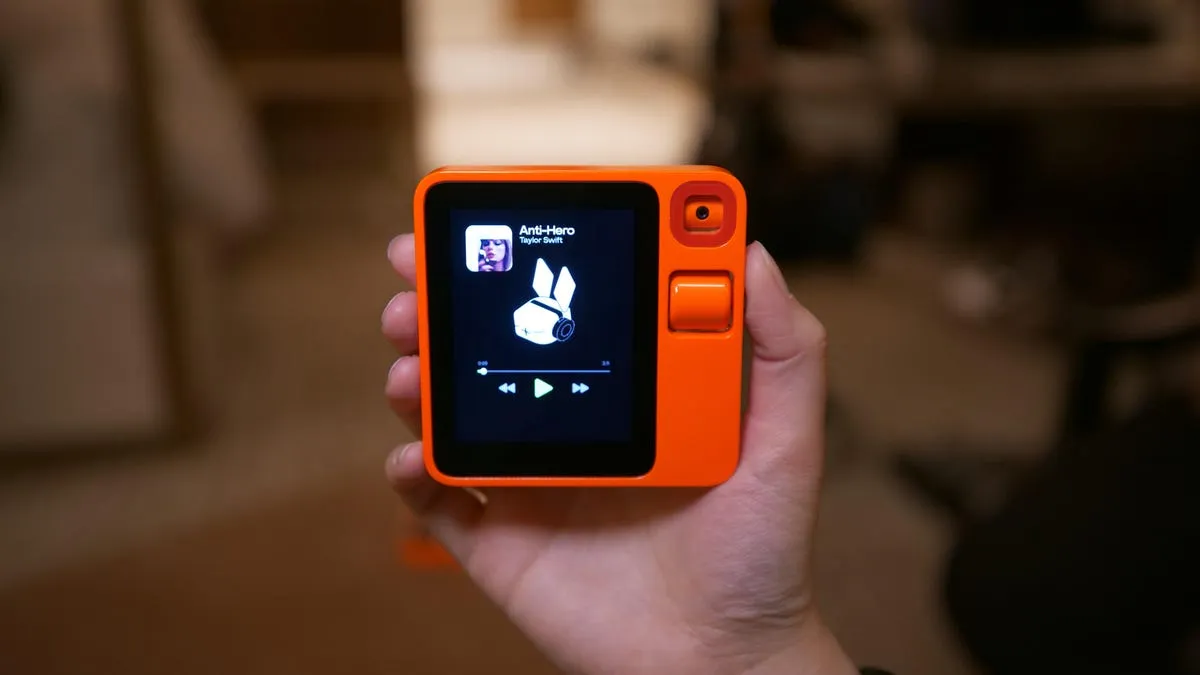The Rabbit R1, introduced at CES 2024, is an innovative AI-powered pocket companion designed to revolutionize the way users interact with technology. Resembling a smartphone in appearance, it features a camera, SIM card slot, and supports Wi-Fi and Bluetooth connectivity. However, what sets the Rabbit R1 apart is its user interface. Rather than a traditional grid of apps, the R1 uses an AI assistant to interact with your favorite apps and perform tasks. This means users can accomplish a variety of actions, such as researching holiday destinations, booking flights, or even queuing up music playlists, all through voice commands.
The Rabbit R1 stands out as a groundbreaking AI-powered device, offering a range of capabilities that push the boundaries of what we expect from personal tech gadgets. Here are some key features and capabilities of the Rabbit R1:
1. AI-Powered Interaction: The core of the Rabbit R1 is its AI assistant, which users can interact with through natural language commands. This assistant is powered by a Large Action Model (LAM) AI, which is reportedly faster in response and results delivery compared to other AI models like ChatGPT.
2. Versatile Task Execution: The device can perform a variety of tasks, similar to those done on a smartphone, but solely through voice commands. This includes researching holiday destinations, booking flights, queuing up music playlists, providing directions, making reservations, and even conducting real-time translations.
3. Hardware Design: The Rabbit R1 features a 2.88-inch color touchscreen, an analog scroll wheel, a rotating 360-degree camera called the Rabbit Eye, microphones, speakers, a USB-C and SIM card slot, and a unique push-to-talk button. This button ensures that the device is not constantly listening, thereby enhancing user privacy.
4. Privacy and Security: Rabbit emphasizes the privacy and security of the user. The device does not store login details or track users. It uses a dedicated and isolated cloud environment for each user to ensure privacy during interactions and task executions.
5. Connectivity and Integration: The R1 can connect to various apps and services through a web portal. Services like Spotify, Apple Music, Uber, eBay, and Amazon are among those that can be integrated, enabling the R1 to perform tasks using these services.
6. Learning and Adaptability: An interesting aspect of the Rabbit R1 is its ability to learn new skills. Users can teach the device how to perform specific tasks, and it can replicate these tasks independently in the future.
7. Communication and Entertainment: The device can handle communication tasks, play music, book services, and even assist with planning vacations. Its ability to analyze images taken with its camera adds another dimension to its versatility.
The Rabbit R1 is indicative of a shift towards AI-first devices in the realm of personal technology. Its blend of innovative AI capabilities, privacy-focused design, and user-friendly interface marks a significant step forward in the evolution of personal computing devices. As with any new technology, there are questions about its real-world performance and integration into daily life, but the Rabbit R1 certainly presents an intriguing glimpse into the future of AI-powered personal technology.
The device itself is compact, fitting comfortably in the palm of the hand, and comes in a distinctive bright orange color. It has a 2.88-inch color touchscreen, an analog scroll wheel, a 360-degree camera (referred to as the Rabbit Eye), built-in speakers, and a far-field microphone. A unique feature of the R1 is its push-to-talk button, which eliminates the need for wake commands like “Hey Siri” or “Hey Google,” ensuring that the assistant isn’t constantly listening.
Internally, the Rabbit R1 is powered by a 2.3GHz MediaTek Helio processor and is said to offer “all day” battery life. For software, it runs on Rabbit OS, fronted by a Large Action Model (LAM) AI. This AI is capable of performing tasks and answering questions, connecting with various apps and services through a web portal. The R1 is designed to maintain privacy, with assurances that it doesn’t store login details or track users. It also promises speedy responses and allows users to teach it new skills.
Priced at $199, the Rabbit R1 does not require a subscription fee, making it a cost-effective option for users. The initial batches of 10,000 units sold out quickly after its announcement, and the R1 is expected to start shipping between March and April 2024.
While the Rabbit R1 has created significant buzz for its user-centric AI functionality and minimalist design, there are still questions regarding its real-world performance and how it will fit into the larger tech landscape. The Rabbit R1 represents a step towards more practical and AI-focused computing solutions, offering a potential new direction in personal tech.



